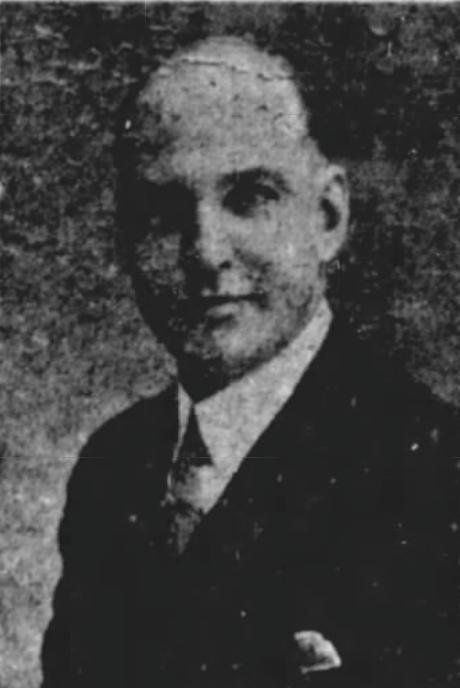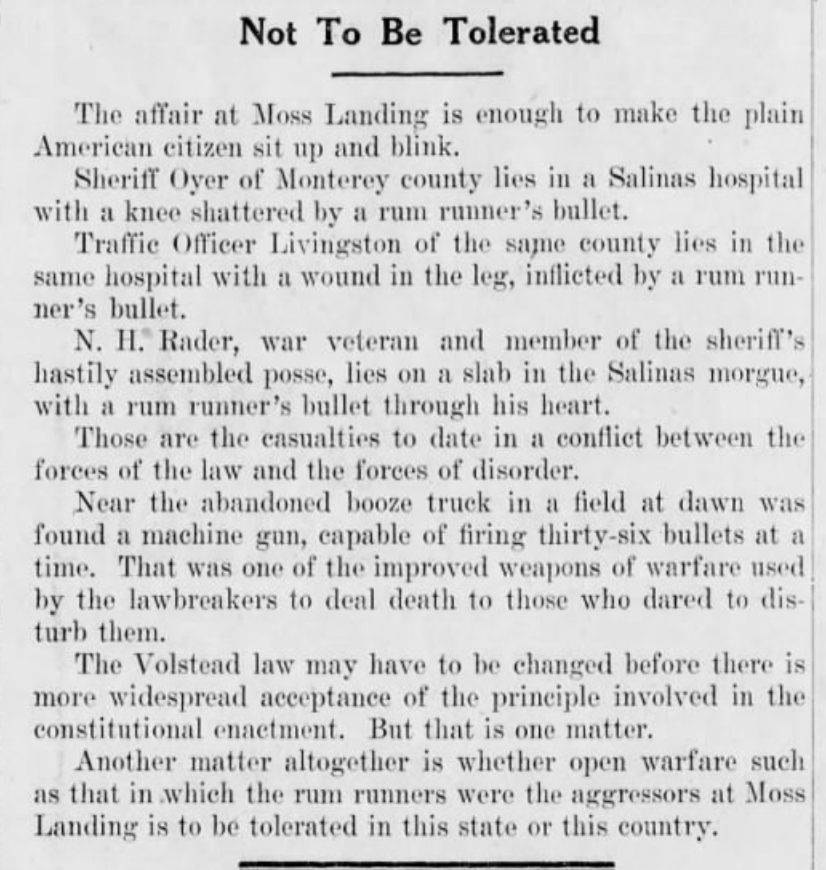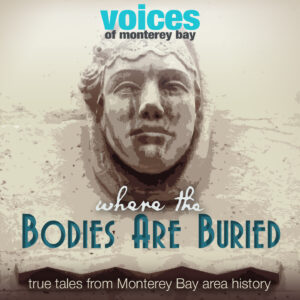| Stock Photo
| WHERE THE BODIES ARE BURIED
PART 1
The Forces of Disorder
Editor’s note: This is the first of a two-part series, presented to gauge reader interest in an ongoing Voices of Monterey Bay feature called “Where the Bodies Are Buried.” To receive a link to Part 2, please participate in our reader survey here.
By Joe Livernois
Noah Rader, a man of fraternal interests, ran a second-hand furniture shop in Salinas. He belonged to veterans groups and was a member of the Salinas Camp of Modern Woodmen of America, an organization that took care of its own back in the 1920s. Rader was also a soldier at heart, so Sheriff William Oyer could count on him whenever an extra gun was needed for a raid. Maybe Rader would get formally deputized, or maybe not. It didn’t really matter at the time. Whenever he’d go out with a posse, the county would send him $5 for the day’s work. A little extra cash helped pay the bills.
On the night of July 6, 1925, Rader finished up his business at the United Veterans of the Republic clubhouse in Salinas. Earlier in the day, the veterans group buried a Civil War hero, and Rader had taken a leadership role in the funeral. Rader himself had been a Rough Rider during the Spanish-American War, fighting under Theodore Roosevelt, and he also took a couple bullets in the Philippines.
As Rader returned home from the veterans club meeting that Monday night, a vehicle slowed to a stop, and Oyer’s voice could be heard from behind the headlight beams:
“Hey. Come on, Rader.”
That’s all it would take. Rader was on board. When Rader climbed into Oyer’s vehicle, the sheriff explained that his regular deputies had seen some sketchy characters in Moss Landing earlier that night. Probably a crew of rum runners. Oyer needed reinforcements to help bust up the gang.
Oyer, a butcher turned lawman, had won the sheriff’s election three years earlier after promising voters he’d “clean up” the vice that permeated Monterey County. Liquor, prostitution and gambling. Once elected, he proved that he was a front-line sheriff, and not one of those political hacks who wore a badge and hid behind his desk. If there was a problem somewhere that required law enforcement’s presence, he usually led the response, out front and with guns drawn.
Enlarge

In fact, Sheriff Oyer and his boys had broken up a liquor landing in Pebble Beach, not far from the yacht club, three weeks prior to the Moss Landing incident. Gunplay was involved, but everyone escaped unharmed. Most of the bad guys disappeared in heavy brush, leaving seven vehicles and 375 cases of booze behind. Those who were apprehended proved to be low-level flunkies who honestly didn’t seem to know who they were working for. Experiences like that taught Oyer that the law would always be outgunned, that the rum runners didn’t play fair. They had machine guns; the cops were armed with shotguns. That’s why extra men like Rader helped. More guns to go up against better guns.
The Volstead Act and Prohibition were in full swing in 1925, a time when the term “illegal liquor” was lawfully redundant. As is usually the case, when the government turns vice into crime, criminals will find a way around the laws. In the case of intoxicants, the dummies and the yahoos had their moonshine, but the smart money was in bulk distribution of legitimate labelled imports. Gangsters and syndicates handled the movement of booze from Maine to California. Whether they were dealing beer, wine or spirits, they were known as rum runners.
Whatever the outlaws were called, crime fighters like Sheriff Oyer believed the bastards were a plague on Monterey County. There wasn’t a huge market for the stuff on the Central Coast, due to population and religious proclivities. at least not compared to the lawless cesspools like Sacramento and San Francisco. Monterey County had been founded by Catholic missionaries who hoped to whip the place into shape. And later, after things settled in, strait-laced Methodists discovered Pacific Grove and turned it into their religious playground. While the Catholics were happy to look the other way, the Methodists wouldn’t abide booze at all.
But Monterey County was relatively quiet, remote and keep-to-yourself. A good spot to get away with nefarious behavior. And the sleepy port villages and the secluded bays on the Central Coast were perfect for the offloading of hooch without detection, for eventual distribution to Big City speakeasies and “social clubs.” Rum boats took anchor in Stillwater Cove, in dark spots along the Big Sur Coast, in the protective cove at Point Lobos shared by whalers and vagrants, and in quiet coastal villages like Moss Landing.
Charles Moss and Cato Vierra had built a wharf and a pier on the Moss Landing shoreline in an effort to move commerce in and out of the region. They must have been enthusiastic about the commercial prospects offered by the confluence of the Salinas River and the wetlands we refer to as the Elkhorn Slough. Moss Landing was a spot of land surrounded by water, with enough dirt in between to move products from ship to shore. The place had its ups and downs. And 10 years after the Great Earthquake of 1906 destroyed the wharf; someone built another one. It was to accommodate the whale trade, which was still a thing, but not for long. Fishing boats still made use of the pier occasionally, but Moss Landing wouldn’t really prosper until the 1940s, when the working harbor was dug. Even before the big power-generating plant and the harbor, Moss Landing never boasted a population of more than a couple hundred souls. And when the tough-talking rum runners showed up, it was simple to convince local yokels to keep their mouths shut. A couple of bottles — gratis — usually did the trick.
An attorney for a rum runner caught up in the Monterey County trade explained the practical economics of the profession to readers of the San Francisco Examiner many years later. His client, a Princeton graduate, could net up to $1,500 a day selling bottles of liquor on the black market. In 2021, that translates to $10,000 daily. The Princeton kid seemed like the innocent type, and his parents wept openly in court for him during a high-profile trail after the law caught up with him in 1925.
Criminals who profited from vice kept lawmen like Oyer busy, and they provided an outlet for adventure to domestic soldiers of fortune like Noah Rader.
* Tell us what you think. Take our survey.
Earlier in the day on July 6, 1925, a motor patrolman named Henry Livingston noticed tanks of gasoline and a clutch of dubious strangers sitting around Moss Landing. Suspicions aroused, he drove into Salinas to alert deputies that rum runners appeared poised to deliver more demon liquor and to pick up fuel. About a half-dozen deputies took a position on a small hill to the east of Moss Landing to survey the action. The rum runners had their own spies, of course, and in time a cream-colored phaeton — in old-timey days, a phaeton was a jalopy without a top — pulled up to the deputies. The driver got out and approached.
“Who are you fellows?” he asked, according to reports carried in the newspapers.
“We are officers,” a deputy said. “Who are you?”
“None of your damn business,” the stranger answered.
A couple of the lawmen approached the vehicle, hoping to search, but the stranger jumped in and whizzed away. After a brief chase, the cops were able to stop the phaeton. “I’ll have to take you into custody for violating the motor laws,” said Livingston, noting that the man had sped away without turning his lights on. The stranger hit the gas again, leaving the officers behind. Again the officers gave chase, but as they hit the highway towards Watsonville, they were greeted by a fusillade of bullets.
Outclassed and outgunned, the officers found a pay phone and called Sheriff Oyer for reinforcements.
Oyer rounded up who he could find that late at night, including Noah Rader. According to later testimony, the sheriff handed Rader a fully loaded pumpgun.
In the darkness, a crew of outlaws waited for the next wave of lawmen. The rum boat, called “Palermo,” had already arrived, but the boys on shore advised the captain to abandon the off-loading operation, rescheduling the delivery to the next day in Tomales Bay. The boys stood on the shore, sharing a bottle of liquor and laughing at William Bowen, a colleague who had fallen into the surf.
Soon, Oyer’s party motored to the outskirts of the village and encountered another suspicious wise guy, posted along the road to watch for trouble.
“What’s going on here?” one of the lawmen, Constable L.A. Beevers, called out.
“You’ll find out pretty quick,” the wise guy said. “You’d better keep on going while you’re all in one piece.”
He then ducked down the bank along the slough and shots started coming from all directions. Ambushed, the lawmen returned fire, but they were blasting shotguns into the night against a spray of the gangsters’ machine-gun fire. Beevers later testified he heard Oyer call out that he had been shot. He trotted towards the sheriff, with Rader not far behind. Another bullet whizzed by Beevers and found its way into Rader’s heart.
Once the shooting stopped, the cops on the scene let Rader’s body lie out there for a while so they could tend to Oyer, who had been shot in the knee, and to Livingston, who had been nicked in the gunplay. The posse couldn’t be sure, but they thought perhaps they had wounded a couple of the bad guys.
The survivors ran Oyer into Salinas so a doctor could tend to his shattered knee. When they returned for Rader’s body, they noted for posterity that he was still holding the stock to the gun and that he had, according to a reporter for the Salinas Daily Index, “fired five shots at his antagonists before falling mortally wounded.”
Noah Horace Rader, a native of Tennessee, a veteran of the Spanish-American War and a man of fraternal interests, was 45 years old. He left at least one wife and a 14-year-old daughter. When listing Rader’s various fraternal interests in Salinas, a local newspaper journalist reporting on his funeral noted that he was “never too busy with personal business to give his time for the good of others.”
Tales and rumors about the “Battle of Moss Landing” echoed across the Central Coast, and local residents could speak of little else for days. Their attitude was probably best summarized by an editorial writer for the Santa Cruz Evening News:
Enlarge

Accounts of the sensational gunfight and follow-up stories about the clues, rumors and speculations about who was involved were splashed across the front pages of newspapers throughout the country for weeks. With such that sort of publicity, the incident captured the attention of determined federal agents who spread out across Northern California in an effort to break up the rum running syndicate. Their investigation turned up a series of astonishing clues, jaw-dropping accusations and inconceivable arrests that kept Moss Landing on the front pages for at least the next five years.
To read Part 2 of The Battle of Moss Landing: Indictments and insinuations, a mayor goes to prison, and Monterey County turns it back on a hero’s daughter, please share your thoughts about Monterey County history and “Where the Bodies Are Buried.” Click here to take the survey and we’ll send you the link.
Have something to say about this story? Send us a letter or leave a comment below.
